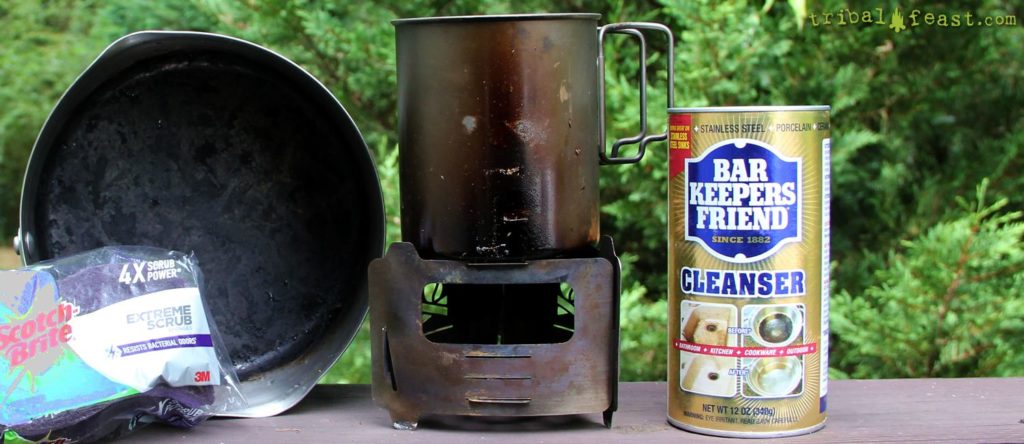When it comes to ultralight outdoor cookware, titanium is hard to beat. Despite weighing a fraction of what a stainless pot would weigh, titanium is strong enough to handle the rigors of the outdoors. But if you’ve ever cooked in a thin-walled titanium backpacking pot or frying pan, you know how easy it is to burn food – and how hard it is to clean. Titanium is definitely not non-stick.
The key to cleaning badly burnt titanium camping cookware is to soften the burnt material by boiling water in the pot or pan, then use the right blend of abrasion, soap, and elbow grease to bring back that intriguing grey titanium luster that we all love so much. Resorting to stronger chemicals and solvents can damage your pot or make it unsafe for cooking.
Let’s dive in deeper into some titanium cleaning tricks that will get your pot looking like new again and keep you from being tempted to turn to harsher, possibly dangerous cleaning methods. But I should make it clear that all of the methods outlined here are for pots and pans that are not coated with anything. Do NOT use any of these methods on Teflon-coated or similar non-stick surfaces!
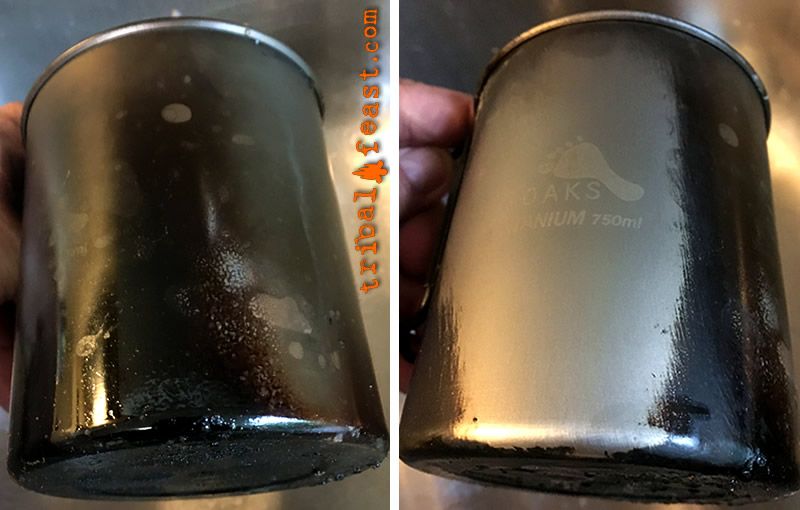
Avoiding Getting Your Pot Nasty in the First Place
I know this sounds like a real smart ass tip, but bear with me on this. Before you start cooking, take a moment to reflect on what a pain it is to clean a burnt up pot, and then be more methodical in your camp cooking using the tips below. As silly as it sounds, taking that moment to reflect before putting your pot on an open flame can make a huge difference.
Don’t Burn Food
Duh. But the reality for me is that the only way I can avoid doing this is to be very cognizant of what I am doing when I am cooking. Paying close attention to the flame intensity of your camp stove and stirring the contents of your cook pot often goes a long way to keeping that pot clean.
I’ve also learned to slow down when cooking in camp. Even when I’m a bit hangry after a long hike, I try to resist the urge to hurry through the cooking process. In the end, being a vigilant and methodical camp chef makes for tastier food and an easier clean up.
Avoid Cooking with Pine
If you cook over a bushbox or campfire, the same rule above applies to keeping tabs on that flame to make sure the fire doesn’t get too hot beneath your pot. But you should also be cognizant of the wood you are using. Wood like pine that is heavy in resins will actually leave a layer of black tar on the outside of your pot.
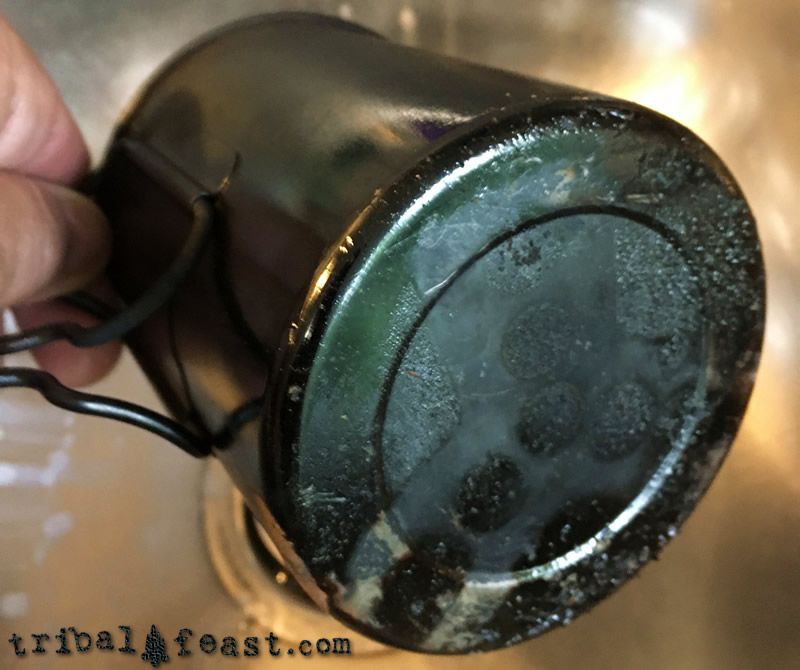
When gathering wood, separate out the hardwoods and use those for cooking. Once dinner is done, then throw those pine logs on the fire. All woods will leave a tarry residue on your pot, but pine can be especially bad.
The Soap Trick
If you do cook over an open fire, this is one of the best tricks you will ever learn for keeping the outside of your titanium pots and pans clean. Before cooking, lightly coat the outside of your pot with dish soap. The soap cooks into the pot and creates a barrier against soot and tar. When you go to wash your pot, the soap will dissolve in water taking the fire filth with it.
A huge thanks to my good friend Ian at ianslack.com for sharing this tip with me. It works like a charm and will save you a lot of elbow grease and frustration.
Cook in Freezer Bags
If you’ve never heard of freezer bag cooking and are tired of scrubbing pots, get ready to get your mind blown! Basically, instead of cooking your meal directly in the pot, you put the ingredients into a Ziploc freezer bag and boil your meal in water. Obviously this is not the best cooking method for a lot of dishes, but it can be a great approach for a lot of egg, fish, and vegetable recipes. And once you’ve had a freezer bag omelet, you will never want to dirty a pan again. Read more about freezer bag cooking here.
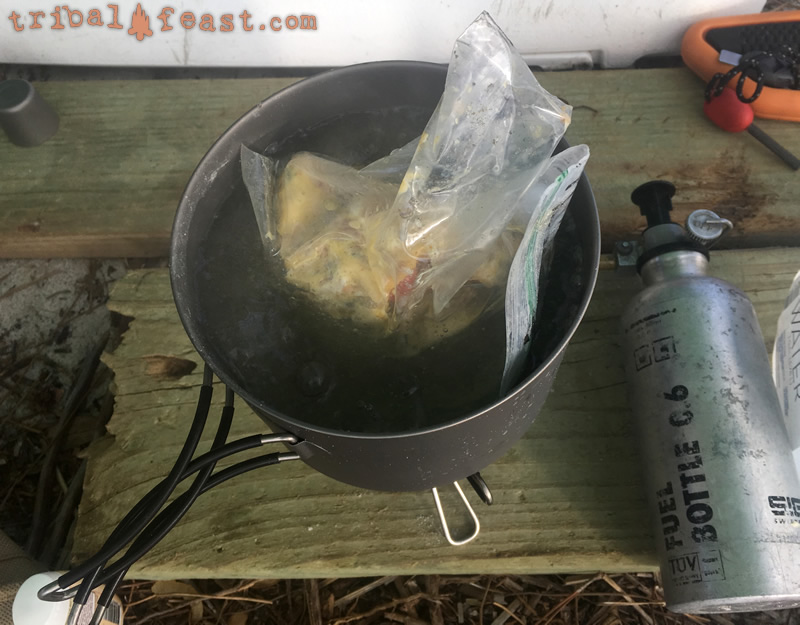
Removing Burnt Food
No matter how vigilant you are when cooking over a camp stove or campfire, it’s going to happen: you will eventually burn food onto the bottom of your titanium pot or pan. But thankfully, titanium can take a lot of abuse and removing charred, crusty food is actually pretty easy if you follow the tips below.
Boil It Off
Without a doubt, the best thing you can do to remove burnt food from a pot or pan is to boil water in it to soften up the baked-on nastiness.
Remove as much of the burnt on food as you can by chipping it out with a spoon, then fill the pot with water and put it back over the fire.
One big downfall to this method is the amount of stove fuel it takes if your only source of cooking fire is a camp stove. You can burn a lot of valuable stove fuel trying to boil away food residue, so it may pay to make a small fire just to boil water in your pot for cleaning. But keep in mind that you will now have to clean the outside of your pot!
Use the soap trick above and the cleaning methods below and balance the value of the camp fuel with the need for a clean pot. If fuel is an issue, use other methods to remove burnt on food. The more pot cleaning tricks you have in your arsenal, the better.
The Plastic Bag Method
This isn’t really a cleaning method so much as a way to mitigate wasting camp stove fuel and time in the woods. And you can do this simply by carrying along a spare plastic bag.
If it is your last day in camp, forego cleaning the nasty cookware and simply wrap it up in the plastic bag. Tackle this chore when you get home and have easy access to water, scrubbing pads, and other cleaning supplies. This is also referred to as the Procrastination Method.
When adventure picnicking, this is always the method I employ. Usually the time constraints don’t allow for cleaning my pots, pans and utensils on the trail. I usually just throw them into a plastic bag and then dump them into a sink full of hot soapy water to soak once I get home.
One Drop of Soap
When you do clean your cookware out on the trail, there are a lot of reasons to keep soap use to a minimum. Beyond wanting to carry less weight (less soap), we also have to be concerned about the impact we have on the environment.
The reality is that it doesn’t take a lot of dish soap to clean a pot and most people use way too much. Generally, one drop along with an abrasive is plenty to scrub out a fairly filthy pot. They trick is to balance out water, the abrasive medium (see below) and the drop of soap to create a sort of gritty lather that can be transferred to another pot or be used to clean utensils once that original pot is clean.
While regular dish washing soap is not extremely toxic, there are better choices for the active outdoors person. The camp soap of choice is, without a doubt, Dr. Bronner’s Pure Castile Liquid Soap, and while you can find it at practically any grocery store, I usually find it cheaper on Amazon. This highly concentrated, all natural, fully biodegradable soap is not just an effective dish soap, but it also makes for a great laundry detergent, body soap and even a shampoo!
A Handful of Dirt
Believe it or not, one of the best things for cleaning a nasty pot out on the trail is dirt! Simply grab a small handful, add a drop of soap and enough water to make a sort of abrasive paste, and start scrubbing.
The effectiveness of a particular dirt as a cleaner has a lot to do with how gritty it is. If the soil where you are camping is not very gritty, see if you can find a pebble or too to add to your pot while scrubbing.
A Handful of Sand
If you are camping by the water, whether by a mountain stream or coastal destination, you should have no problem finding a patch of sand and a nice spot to wash your dishes.
Sand is without a doubt one of the best abrasive titanium pot cleaners you can use when out on the trail. Not only is it 100% natural, but it is usually found in abundance. While this is a very aggressive thing to use for cleaning a pot, I’ve never had it harm or badly scratch any of my titanium cookware. Titanium is some tough stuff!
If you have a pot with a particularly bad crust of burnt food, start out with simply water and a small handful of sand and stones and go to work on the offending residue. Occasionally, dump out the sand and stones to see what you are left with and repeat the process until the majority of the burnt food is gone.
Once you are left with something more akin to a stain than a crust, get a fresh small handful of sand and mix this with soil, soap, and a small amount of water until it is the consistency of toothpaste. As above, repeat this process with occasional rinses until you are happy with the results.
Removing Black Tar and Soot
As mentioned above, if you cook over a fire or use a twig stove like the Bushbox Ultralight (read my review here), you may find the outside of your pot a bigger challenge to clean than the inside. Tar and soot can get pretty thick on a pot after a long weekend of cooking and the resultant black, sticky residue can be a real challenge to clean.
Use the aforementioned soap trick to keep the soot and tar from building up, scrubbing the outside of your pot with sand or soil between meals and reapplying a layer of dish soap as needed. But keep in mind, even this will not keep the outside of your pot 100% clean.
Generally, while out in the woods, if a layer of black soot and tar builds up, I just ignore it and focus on keeping the inside of my pot clean. When it is time to hike out, I simply shove my pot into a plastic bag and deal with it when I get home – the Plastic Bag Method outlined above.
When it is time to deal with that nasty sticky tar, the following tips for at home cleaning in the sink go along way in getting that titanium pot or pan looking like new again.
Avoid Chemicals
I see a lot of forum posts and blog articles out there on the internet suggesting using more caustic substances like oven cleaner and carburetor spray to clean a filthy titanium camping pot. I think if a cooking pot was so far gone that I would have to resort to chemicals such as these, I would trash the pot and replace it with a new one.
Health is another concern here since these chemicals were not designed to be used on dishes and may leave behind toxic substances that will be in contact with your food. Play it safe and avoid the temptation of using toxic chemicals as a shortcut. I’ve never had a pot I couldn’t clean with any of the more safer methods I’m recommending.
Natural Cleaners
While this isn’t my preferred method, a great natural way to clean stubborn campfire tar and soot of a titanium pot is a mixture of lemon juice and table salt. I’m not sure about the exact chemical reactions that come into play, but the citric acid does seem to do a great job in dissolving the tar and the salt seems to act as an effective abrasive.
The best way to go about this is to use a dishrag soaked in lemon juice. Pour a healthy dose of table salt into it and start scrubbing. The dishrag will end up pretty tattered after cleaning a pot, so having a specific sacrificial rag solely for cleaning camping cookware is highly recommended.
Bar Keepers Friend
This is without a doubt my favorite kitchen cleaner of all time. It is basically a more natural alternative to Comet and is completely safe to use on cookware. My understanding is that kitchen cleaners like Comet and Ajax are alkaline (bleach) based and contain harsh, man-made chemicals, whereas Bar Keepers Friend is acid based and uses milder, more nature-based agents to clean.
Whatever the case, I know from the experience of using it that it is not nearly as harsh on either my pots or my hands as bleach-based cleaners, yet it has the abrasive qualities of powdered cleaners like Comet that make it great for removing stubborn campfire tar and soot.
If your pot is particularly charred, you will need to use a lot of Bar Keepers Friend to get it clean. I usually dump a small pile onto the surface I want to clean and drip water into it until I get a thick paste. This isn’t much different than making a paste of soap, water, and dirt when out on the trail and I think the real trick to cleaning is in getting that paste the right consistency.
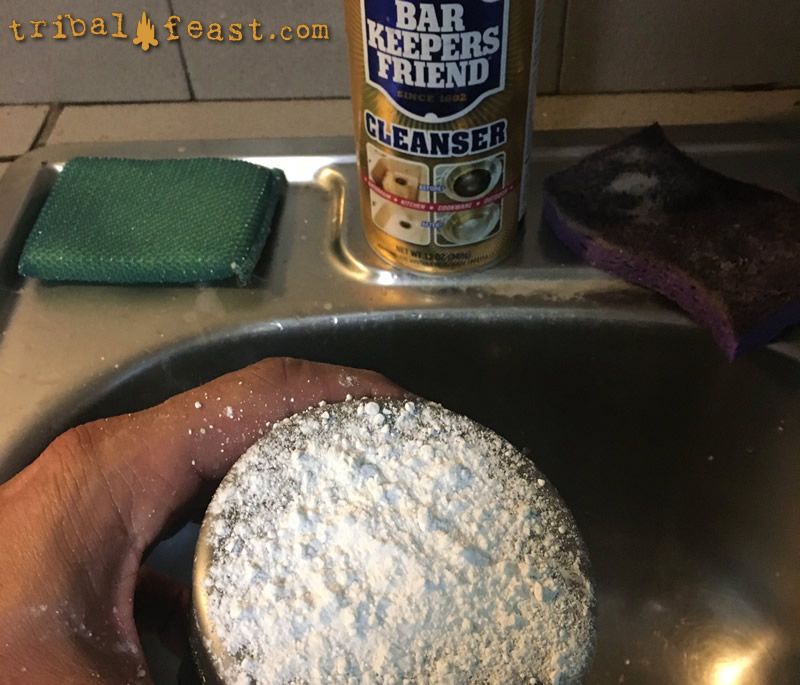
For the actual scrubbing, I use the rough side of a Scotch-Brite pad. They seem to hold up well and the thicker profile of the sponge gives you both something to grip and some protection for your knuckles.
Once you’ve been scrubbing for a bit, you will notice your Bar Keepers Friend paste will start to get watery. At this point, I will generally rinse it off to see what progress I’ve made. If there is still some residue, I just dump on some more Bar Keepers Friend and repeat the process until I’m satisfied with the results. Another product I usually buy in 2-packs off of Amazon.
Restoring Discolored or Blued Titanium Cookware
I’ve occasionally run into someone who was very concerned about their titanium cookware becoming permanently discolored from use. And we are not talking about a black crust of tar, but rather the blueish, rainbow-like hues that are a common occurrence when titanium is repeatedly exposed to heat and flame.
I personally find this blueing of titanium kind of cool and simply consider it a badge of honor for a well-loved camp pot. And I recommend you adopt this stance as well because the reality is that no amount of scrubbing or cleaning will make that discoloration go away.
This blueing is a common occurrence and is a result of the titanium being exposed to intense heat. Unless there is some physical damage to the pot like cracking or melting (both of which are highly unlikely), this discoloration is not a problem and the pot is perfectly fine to use.
So embrace your weird bluish-tinged cook pot! Know that that discoloration only proves you are an avid outdoors person!
Final Thoughts on Titanium Cookware
Many years ago when I first started camping and backpacking, titanium cookware was both exotic and crazy expensive. Because I couldn’t afford it at the time, my first camping cookset was a great quality, but very heavy, stainless steel set made by MSR.
Many of the cleaning methods outlined above I learned from cleaning burnt food and campfire tire off my stainless steel camp cookware and will work on your stainless camp cookware as well as stainless pots and pans in your kitchen at home.
But titanium is really the only way to go for adventure cookware. It has come down in price substantially since my early days of camping and there are a myriad of companies making great quality, yet affordable, titanium camping cookware.
My favorite is without a doubt TOAKS, so if you are looking to replace your current cookware with titanium, please read my TOAKS review and my recommendations of which titanium pots and pans are best for which specific outdoor application.
If you haven’t switched to titanium cookware, I highly recommend you do!

